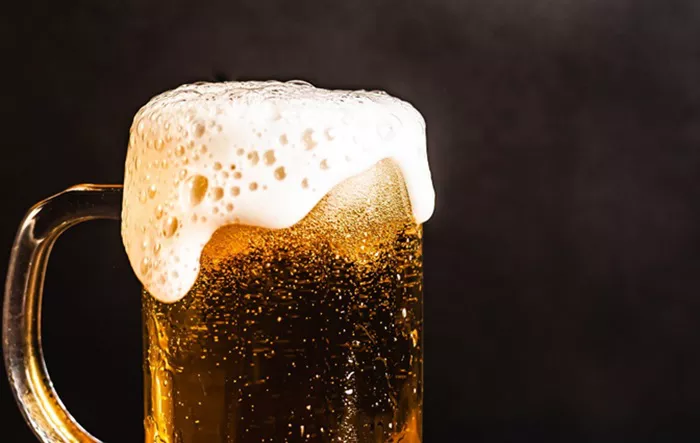As the popularity of Dry January and similar initiatives grows, the craft beer industry is responding with a burgeoning market for non-alcoholic (N/A) beers. Ryan Frank, the Vice President of Operations and Head Brewer at Headlands Brewing, first embraced Dry January a decade ago while vacationing in Tahoe with his wife. After a day on the slopes, he sought a drink but was committed to abstaining from alcohol.
“How do you get off the mountain without a beer?” Frank recalled. “My partner and I tried every single N/A beer we could find, and Erdinger Kristallweiss was my favorite back then.”
Over the past ten years, Frank has witnessed a significant cultural shift as more breweries have begun to craft non-alcoholic beers. A decade ago, he noted that most high-quality N/A options were sourced from Germany, which has been ahead in this market segment. As trends like Dry January and Sober October gain traction, U.S. breweries are increasingly developing their own alternatives. Despite being a professional brewer who still samples beer in January, Frank sees N/A months as a chance for a “healthy reset,” emphasizing a more balanced relationship with alcohol.
The Fast-Growing Segment of Non-Alcoholic Beer
Non-alcoholic beers are currently the fastest-growing segment of the beer industry, according to multiple brewers. One notable player in this space is Connecticut’s Athletic Brewing, which was founded in 2017. Many breweries in the Bay Area offer N/A beers from other companies, but Fieldwork Brewing stands out as one of the few East Bay breweries producing its own. The brewery currently offers three varieties: a West Coast IPA, a hazy IPA, and a grapefruit blonde, with plans for additional flavors.
“Our goal is to make it so you can’t really tell the difference between N/A and regular beer,” said Ian Gordon, Fieldwork’s Director of Marketing. “We want to create something better than Athletic Brewing.” Unlike their regular beers, which are primarily self-distributed, Fieldwork plans to broaden the reach of its N/A offerings, now available in Northern California and set to expand into Southern California.
“There’s a demand for it, or else we wouldn’t be doing it,” Gordon added.
Challenges for Small Breweries
While the rising trend of N/A beers presents opportunities, it also poses challenges for smaller breweries. John Gillooly, Head Brewer and Owner of Brix Factory Brewing, notes that Fieldwork, having opened its ninth taproom in Roseville, is well-positioned to focus solely on self-produced products. However, many smaller breweries face obstacles such as costs, demand, available space, and food safety regulations.
Frank elaborated that while there is potential in the N/A market, established players like Athletic Brewing and Sierra Nevada have a substantial head start in distribution and brand recognition. He shared his surprise at the low sales of N/A beers at Headlands’ two taprooms, which average only 0.5-0.7% of total sales.
“Even at that small percentage, we want to offer a little bit of everything,” Sharp said, acknowledging the presence of hard kombucha, ciders, and wines at their establishments.
Brewing N/A Beer: Methods and Safety Concerns
The production of N/A beers typically employs one of two methods, according to Frank. The first involves a standard fermentation process with controlled sugar production and yeast that produces minimal alcohol. The second method brews regular beer before removing the alcohol through techniques like vacuum distillation or reverse osmosis.
However, without alcohol, the challenges of food safety increase. “Alcohol is a good sanitizer, so we have to be more cautious with N/A beers,” Sharp explained. To ensure food safety, N/A beers are often pasteurized, a process that can alter flavors. Flash pasteurization occurs before packaging, while tunnel pasteurization happens afterward, minimizing flavor impact.
These food safety concerns contribute to the rarity of N/A beers on draft, as bars may lack the necessary controls. Many establishments choose to serve N/A options directly from cans, where they have been stabilized through pasteurization.
Exploring Alternative Offerings
While many breweries in the Bay Area do not produce their own N/A beers, several are exploring hop water, a simpler alternative made by flavoring sparkling water with hops. Stephen Ruddy, Brewer at Oakland United Beerworks, described his process of creating hop water, emphasizing its appeal as a non-alcoholic option.
“I’m using sterile water and adjusting the pH to make it slightly more acidic,” Ruddy explained. “Then we add about 30 pounds of hops and allow them to steep cold to impart flavor without bitterness.”
Taste Testing N/A Beers
During a visit to Brix Factory Brewing, Gillooly and Fieldwork Brewer Zack Bassett conducted a side-by-side taste test of N/A beers. Gillooly expressed skepticism about the market for N/A beers, but after sampling Fieldwork’s Headliner N/A IPA, he acknowledged its superior taste.
“It’s actually quite decent,” Gillooly remarked, deciding to carry Fieldwork’s N/A IPA at Brix after noting its balance of flavors compared to other brands.
Bassett explained that while creating N/A beers poses challenges, particularly in replicating the flavor and mouthfeel of alcoholic counterparts, there is a demand for IPAs among consumers seeking non-alcoholic options.
“It’s hard to replicate a strong IPA without alcohol,” Bassett noted.
A Tool for Moderation
Across the craft brewing landscape, many brewers and customers view N/A beers as a means of moderation. Frank emphasized the benefit of having an N/A beer as a last drink of the evening, balancing the desire for a beer with the responsibilities of parenthood.
“I still want a beer, but I don’t really need one more at the end of the night,” Frank said, highlighting the evolving relationship consumers have with alcohol in today’s society.
As non-alcoholic beers continue to gain popularity, the craft brewing industry is adapting to meet the changing demands of consumers, reflecting a broader trend towards mindful drinking and healthier choices.
You Might Be Interested In:


